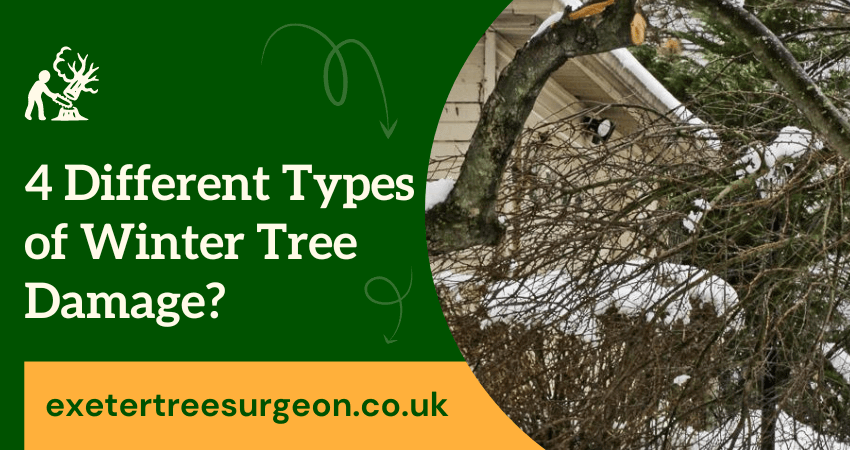Winter can be a harsh season for trees, causing damage in a variety of ways. Some common types of winter tree damage include freeze damage, sun scald, snow damage and animal damage. Understanding the different types of winter tree damage can help you identify and address any issues that may arise with your trees during the colder months.
In this article, we will explore the different types of winter tree damage, their causes and ways to prevent and repair them. Keep reading to learn more about identifying common problems caused by cold temps and ice storms!
4 Types of Tree Damage That Can Occur in Winter?
- Freeze Damage: When temperatures drop below freezing, sap in the tree’s cells contracts and can cause damage to bark and branches. In severe cases, freeze damage can even be fatal to trees.
- Sunscald: Sunscald occurs when the warm winter sun heats a tree’s bark during the day, only to have freezing temperatures come back at night. This causes the bark to crack and can lead to fungal diseases like cankers.
- Snow Damage: Heavy snowfall or ice storms can cause branches to break due to the weight of the snow or ice on them, which can be particularly damaging in young trees.
- Animal Damage: Animals such as deer, rabbits and squirrels can cause damage to trees in the winter. Deer may nibble on bark or rub their antlers against trees, while rabbits and squirrels may chew on tree branches.
Damage from ice and snow?
Heavy snow or ice can cause branches to break due to the added weight. This is particularly common in young trees, as their branches are not yet strong enough to withstand the extra pressure from accumulated snow and ice. To prevent damage from heavy winter weather, you should prune your trees regularly and use tree wraps if necessary.
Additionally, making sure your trees are well-hydrated before winter sets in can help reduce the risk of damage. If you do experience breakage due to snow or ice, it is important to prune away any broken branches immediately to prevent further damage.
Damage from wind
Wind can cause serious damage to trees in the winter, especially if it is accompanied by ice or snow. Strong winds can tear off branches, uproot trees and even break trunks. To protect your trees from wind damage, you should try to plant them away from structures like buildings or fences that could block some of the wind’s force.
Additionally, using stakes and guy wires to provide extra support for your trees can help reduce the risk of wind damage. Finally, you should make sure your trees are well-hydrated before winter sets in to give them extra strength and resilience.
Damage from pests and diseases
In the winter, pests and diseases can also be a threat to trees. Pests such as bark beetles, caterpillars and scale insects may feed on trees in the winter months. Diseases like cankers, root rot and rust can also cause damage to trees during this time.
To protect your trees from these issues, you should regularly inspect for signs of pests or diseases. Pruning and fertilizing your trees can also help ward off problems. If you do detect any pest or disease issues, contact a tree care professional to assess the situation and provide advice on how to address it best.
Overall, being aware of the different types of winter tree damage is essential for keeping your trees healthy and safe. Taking preventative steps like pruning, fertilizing and wrapping your trees can help reduce the risk of winter damage. If you do experience winter tree damage, make sure to address it quickly to minimize any long-term problems or losses.
How To Repair Winter Tree Damage?
- Prune Away Dead Branches: If your tree has suffered from winter damage, it is important to prune away any dead branches that have broken off. This will help promote healthy new growth and prevent further issues from arising later down the road.
- Fertilize: After pruning, you should also fertilize your tree with a balanced fertilizer containing nitrogen, phosphorous and potassium. This will help boost the tree’s health and promote new growth.
- Mulch: Adding a layer of mulch around your tree can also help protect its roots from cold temperatures in the winter. Make sure not to pile the mulch too high as this can cause issues with pests and disease.
- Regular Inspections: Finally, it is important to regularly inspect your tree for signs of pests or diseases. If you do detect any issues, contact a tree care professional immediately to address the problem before it causes further damage.
Following these steps can help ensure that your trees remain healthy and safe during the winter months. With proper care and maintenance, you can keep your trees looking beautiful all year round!
Prevention tips for keeping your trees healthy in winter
- Prune regularly: Pruning your trees before winter sets in can help reduce the risk of winter damage. Regularly pruning will also help promote healthy growth and improve the overall look of your trees.
- Water deeply: Making sure that your trees are well-hydrated before winter arrives is essential for keeping them healthy. Deeply water your trees so that the roots absorb plenty of moisture before colder temperatures hit.
- Wrap or protect trunks: Wrapping or protecting your tree’s trunk with a covering like burlap can help reduce the risk of frost and freeze damage, especially in young trees.
- Plant away from structures: When planting new trees to protect them from wind damage, you should try to plant them away from structures like buildings or fences. This will help reduce the risk of wind damage and provide extra support for your trees.
- Regular inspections: Regularly inspecting your trees for signs of pests or diseases can also help reduce the risk of winter damage. If you do detect any issues, make sure to contact a tree care professional as soon as possible to address them quickly and effectively.
Following these tips can help ensure that your trees remain healthy during the winter months. Taking preventative steps like pruning, watering deeply and wrapping or protecting trunks can help reduce the risk of winter tree damage and keep your trees looking beautiful all season long!
Final Words
Winter is hard on trees. Some tree damage during winter is cosmetic and the tree will recover with tender loving care. Other types of damage are more severe, such as broken branches or trunks that can leave a gap in your once full, green canopy.
Girdling roots can be another problem caused by heavy snowfall and ice buildup that severs the vital connection between the roots and leaves. If you think your tree has suffered any type of winter injury, give us a call.
Our arborists are always happy to take a look and offer their professional opinion on what course of action should be taken to save your tree or determine if it’s time to start over with a new planting.



